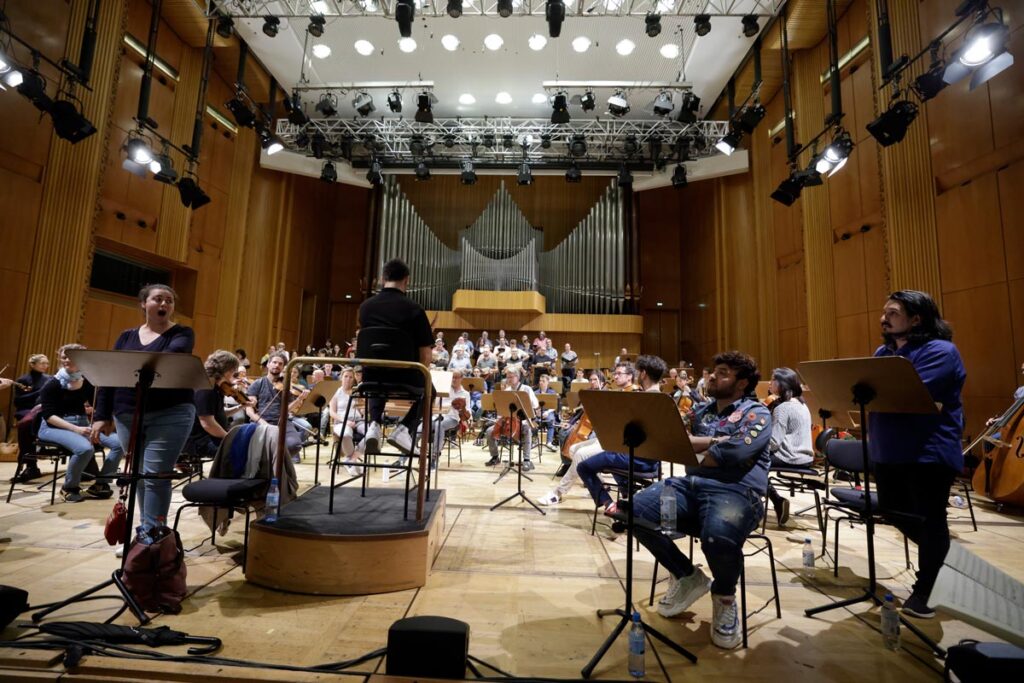There is a magic in every beginning.
And it was precisely this magic that Germany urgently needed after the Third Reich and the Second World War. In addition to housing and food, spiritual nourishment was of course important, and so a lot of money went into setting up the state broadcasters, of which the WDR is one of the largest. In the absence of an extensive sound archive, a good broadcasting hall was also needed quickly so that the music to be broadcast could be recorded with the radio orchestra in time for the broadcasts at any time. It is therefore not surprising that the new large broadcasting hall, which was later named after the first WDR director Klaus von Bismarck, was put into operation in October 1950. This inauguration was intended to set an example, document a new beginning and enchant: none other than Igor Stravinsky conducted the German premiere of his Symphonies d’instruments à vent.
WDR maintained this innovative direction for many years, working closely with pioneering composers such as Karlheinz Stockhausen and Hans Werner Henze, who worked with the radio orchestra both in the legendary Studio for Electronic Music and in the broadcasting hall.
Like many broadcasting halls, the Bismarck Hall is unusually proportioned: A large stage for an orchestra of up to 150 musicians sits opposite a mere 650 visitors. For the musicians playing, this creates a feeling of intimacy and relaxation. You never have the feeling that you have to cater to the world’s attention (which is certainly how it feels in halls such as the Berlin Philharmonie, the Great Hall of the Vienna Musikverein or Carnegie Hall), but rather play almost for yourself. This encourages experimentation with sounds and dynamics, as the willingness to take risks increases.
While visitors are happy about the central location near the cathedral, train station and countless breweries, musicians delivering instruments are far less happy about the local traffic chaos and the lack of parking nearby.
Once you have made it there, however, this inconspicuous hall is a prime address for concerts and recordings. The control room next to the stage and several smaller studio rooms in the vicinity, together with the first-class acoustics, ensure the best working conditions.
You can hear yourself and your colleagues effortlessly, making it easy to integrate yourself into the sound, the hall offers enormous dynamic reserves and resonates even in the quietest pianissimo. Thanks to several thick walls surrounding the hall, not even the mighty bells of the nearby Cologne Cathedral can disturb a delicate recording.
Due to the rather warm basic sound, which is characteristic of many halls of this period (Sendesaal Bremen), sound engineers are rewarded with an even more beautiful sound if they position the microphones meticulously, but it doesn’t immediately cut your ears if you are a little off.
The WDR Nachtmusiken are a special tip if you want to visit the Klaus von Bismarck Hall. You can enjoy very special programs live, listen to the broadcast afterwards at home and thus have an exciting comparison between the sound live and from the recording.
Music tips – recordings that capture the sound of the venue:
WDR Sinfonieorchester Köln, Karl Böhm: Beethoven/Mozart/Dvořák/Brahms, The Cologne Broadcasts 1976/1978/1980, Weitblick 2015/WDR | WDR Sinfonieorchester Köln, Charles Munch: Fauré/Liszt/Debussy/Roussel, The Cologne Broadcasts 1966, Weitblick 2016/WDR



